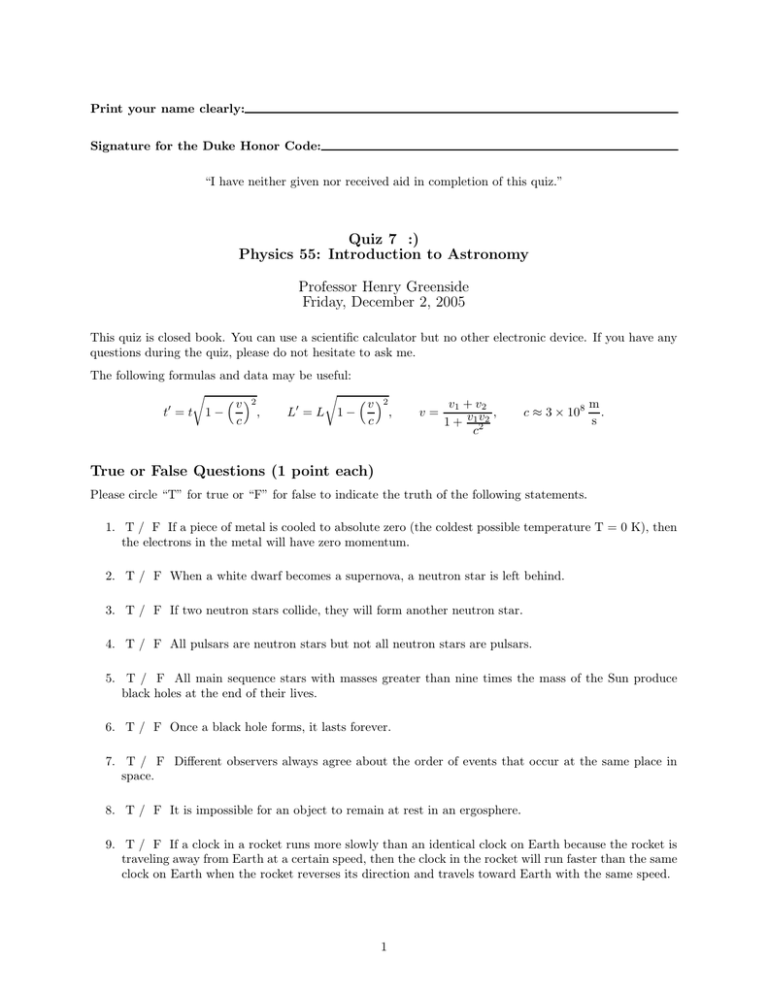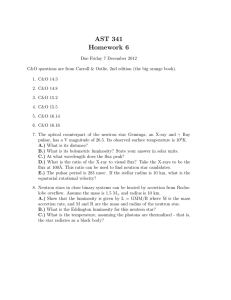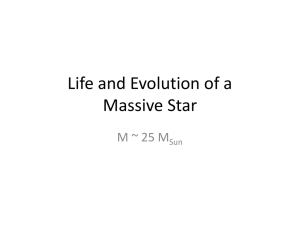Print your name clearly: Signature for the Duke Honor Code:
advertisement

Print your name clearly: Signature for the Duke Honor Code: “I have neither given nor received aid in completion of this quiz.” Quiz 7 :) Physics 55: Introduction to Astronomy Professor Henry Greenside Friday, December 2, 2005 This quiz is closed book. You can use a scientific calculator but no other electronic device. If you have any questions during the quiz, please do not hesitate to ask me. The following formulas and data may be useful: r r v 2 v 2 , L0 = L 1 − , t0 = t 1 − c c v= v1 + v 2 , 1 + v1 2v2 c c ≈ 3 × 108 m . s True or False Questions (1 point each) Please circle “T” for true or “F” for false to indicate the truth of the following statements. 1. T / F If a piece of metal is cooled to absolute zero (the coldest possible temperature T = 0 K), then the electrons in the metal will have zero momentum. 2. T / F When a white dwarf becomes a supernova, a neutron star is left behind. 3. T / F If two neutron stars collide, they will form another neutron star. 4. T / F All pulsars are neutron stars but not all neutron stars are pulsars. 5. T / F All main sequence stars with masses greater than nine times the mass of the Sun produce black holes at the end of their lives. 6. T / F Once a black hole forms, it lasts forever. 7. T / F Different observers always agree about the order of events that occur at the same place in space. 8. T / F It is impossible for an object to remain at rest in an ergosphere. 9. T / F If a clock in a rocket runs more slowly than an identical clock on Earth because the rocket is traveling away from Earth at a certain speed, then the clock in the rocket will run faster than the same clock on Earth when the rocket reverses its direction and travels toward Earth with the same speed. 1 Multiple Choice Questions (4 points each) Circle the letter that best answers each of the following questions. 1. Which one of the following features of a black hole is especially important when trying to distinguish the accretion disk of a black hole from the accretion disks of neutron stars and of white dwarfs? (a) Its mass. (b) Its electrical charge. (c) Its angular momentum (speed of rotation). (d) Its strong gravitational field. (e) Its lack of a physical surface. 2. A quasar is (a) a certain kind of star. (b) the end product of a certain kind of star. (c) a certain kind of nebula. (d) a certain kind of galaxy. (e) a certain kind of nucleus of a galaxy. 3. The object know as Sgr A* is (a) a white dwarf. (b) a neutron star. (c) a binary system consisting of two neutron stars. (d) a black hole (e) a bright compact source of radio waves. 4. Which of the following statements about degeneracy pressure is not true? (a) The degeneracy pressure increases when the core of a star becomes hotter. (b) The degeneracy pressure increases when the core of a star becomes denser. (c) The degeneracy pressure can no longer increase when the fastest moving electrons are moving close to the speed of light. (d) Degeneracy pressure can halt the gravitational contraction of a star even when fusion has stopped in the star’s core. (e) Degeneracy pressure can only be understood in terms of quantum mechanics. 5. Molly flies her rocket past Nick at constant speed v. Molly and Nick both measure the time it takes the rocket, from nose to tail, to pass Nick. Which one of the following statements is true? (a) Molly and Nick measure the same amount of time. (b) Molly measures a shorter time interval than Nick. (c) Nick measures a shorter time interval than Molly. 2 6. In the following figure (a) (b) (c) (d) (e) (f) (g) the square in (a) is initially at rest and is then accelerated up to a constant speed close to the speed of light in the direction shown. Circle the picture (b) through (g) that best indicates how the square will appear to you as it passes by you at high speed. Open Questions 1. (6 points) Describe briefly and clearly the physical meanings of the symbols t0 , t, and v in the formula r v 2 0 t =t 1− . c 3 2. (6 points) The starships Picard and LaForge are traveling with constant speeds in the same direction away from Earth, toward the Andromeda galaxy. The Picard is moving with a speed of 0.9c relative to LaForge, and LaForge is moving away from Earth with a speed of 0.1c. A person on LaForge measures the lengths of the two ships along the direction of motion and finds that they have the same value. If a person on the Picard now measures the lengths of the two ships, explain whether or not the lengths will also be the same. If not, which ship is longer and which ship is shorter? (You need to justify your answer to get any credit.) 4 Extra Credit In the space below, you can answer one of the following problems for extra credit (indicate clearly which problem you choose to solve). 1. (4 points) An astronaut sitting motionless in space fires two lasers at exactly the same time and in exactly opposite directions. With what speed is the front of the light waves from one laser moving away from the front of the light waves from the other laser? You need to justify your answer to get any credit. 2. (6 points) Describe three everyday consequences that would occur if the speed of light were much slower and had the same value as the speed limit for Durham city streets of 35 miles per hour. 3. (8 points) A high-precision atomic clock is placed at the North Pole and a second identical clock is placed on the Earth’s equator. Assuming the Earth is a sphere with radius R = 6, 400 km, how much extra time will one clock read over the other clock after a year has elapsed according to the North Pole clock? Make sure to indicate clearly which clock leads and which clock lags. 5


